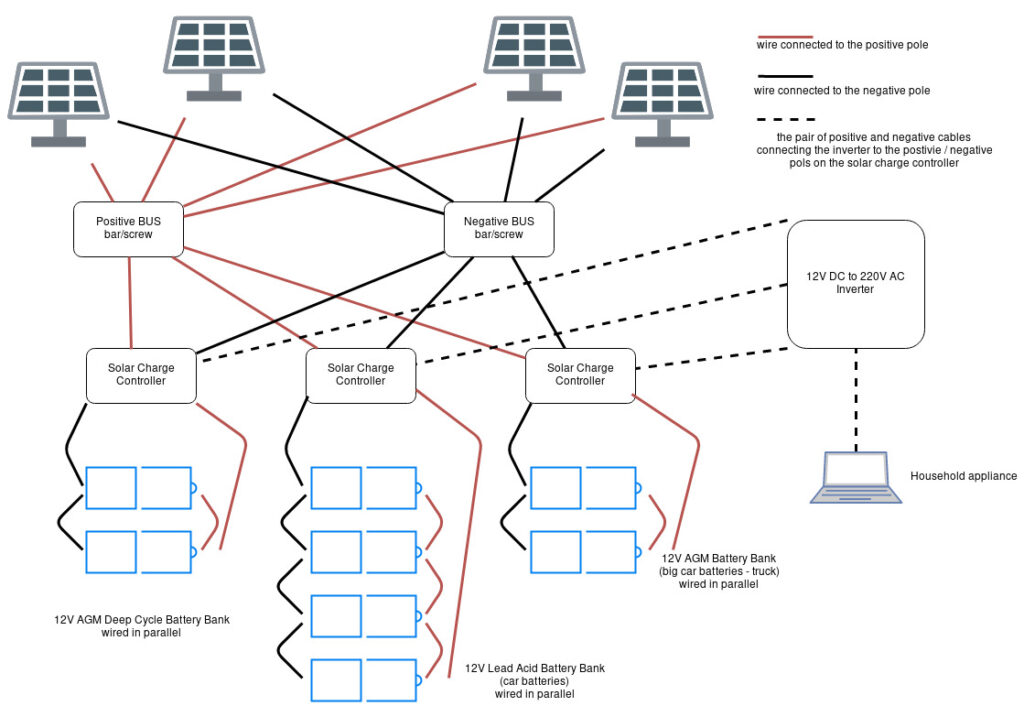It’s been a few months since I deployed the solar system (aka the power plant as we call it) and it worked ok considering weather in the UK and the fact that it is a really small rig.
Now I had another crazy idea (prepper style) and that is: why not try to mix it up a bit? … and by that I mean add various types of batteries to it, connect the charge controllers in ways in which they were not necessarily designed to be connected, stuff like that… reasoning here being suppliers change stocks, in a few years from now you will not be able to find the same battery type, in a prepper scenario when the world as you know it ended you might have to work with what you find (including old used car batteries) so worth looking into this option … right ?
A few months ago the boss (wife) was browsing Marketplace for deals and she found used car batteries for a relatively decent price so we decided to give it a go.
Got 7 used batteries (different types and sizes) – some big some small, some AGM, some classic lead acid, some broken, some working in relatively decent condition and started doing some research into how to connect them together to expand the solar system I have.
After doing some research I realized it might not be a good idea to have them all setup as a big battery bank so I decided to configure them in battery banks (3) grouped by type (AGM/Gel, AGM and classic Lead/Acid).
I ordered a few more bits and bobs from Amazon (connectors, cables, extra solar charge controller, battery tester and desulfator, etc) and got my hands dirty.
One of my ideas was to get 2 battery banks (old batteries) to charge the other (new batteries) BUT that did not work (because charge current needs to be higher ) so now I’m trying to rewire the solar panels so that 4 solar panels send charge current to 3 solar controllers.
A few more months later I noticed I was not getting enough juice on cloudy days and figured out the source of the problem -> the solar charge controllers that came with the kits were PWM and given the number of batteries I had connected to the rig and the cloudy weather I’d say they were struggling. After replacing them with MPPT controllers things changed dramatically … I was getting more juice than ever and that happened even on cloudy days so I’d say that was a smart move. (I still have the old PWM controllers should I ever need to further extend the solar rig)
Notice how I grouped the batteries by type and capacity. This is important because otherwise you risk having unwanted accidents (batteries overheating and even exploding) not to mention unbalanced battery banks which is sub optimal.
Because the inverter I got originally generates a modified sine wave (a cheap inverter basically) it will not be good enough to power the fridge or a UPS so now I’m looking at getting a pure sine wave inverter (about 4 times more expensive than the one I currently have) and after that I’ll be able to connect more sensitive stuff (fridge, ups, laser printer, etc)
Please remember this: I am not an expert at this stuff. I’m figuring stuff out as I’m trying to build a flexible solar rig as a proof of concept for something that would work with both quality stuff (notice the AGM Deep Cycle stuff) as well as used / cheap batteries (noticed the Lead Acid car batteries). My purpose from the beginning was to build a flexible solar system for home that would power enough household appliances and do so in a safe, reliable and sustainable way (what if you can no longer find batteries of same spec as the ones you started with? what if nobody makes batteries anymore ? what if you want to perform maintenance on your solar system AND at same time use household appliances ?)
If you’re planning on doing this please remember to take all the necessary safety measures before working with electricity (safety gear, never work on both positive and negative, avoid working on a live system – power off the system then work on it then when work complete power back on).
Standby for more …
